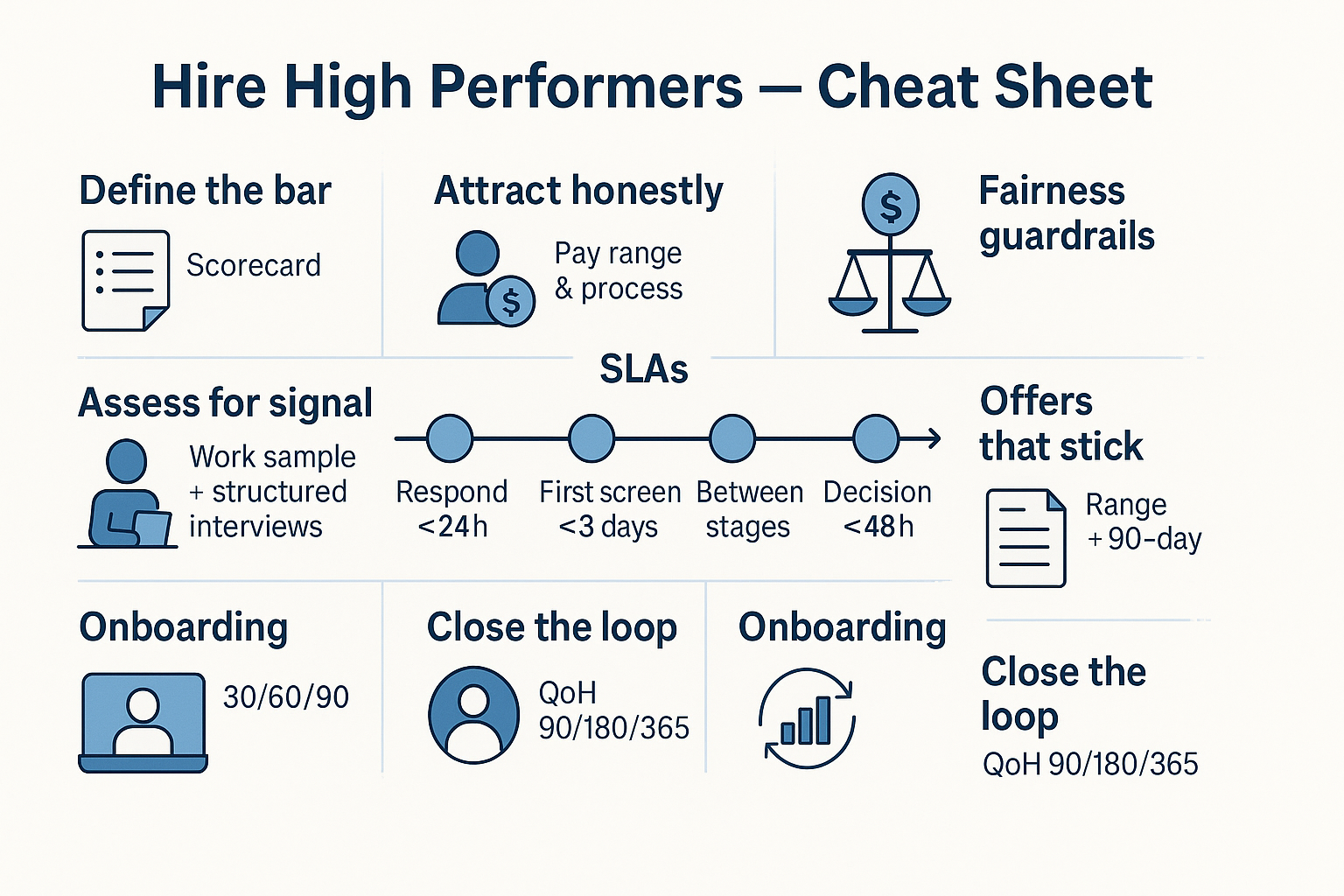Hiring High Performers – 8 steps + Quick kit

Let’s talk about what actually works. Great hiring isn’t magic. It’s a handful of habits done the same way, every time.
1. Start with a one-page scorecard
Before you post the job, write a simple page:
- 3–5 outcomes you need in the first year (real business results)
- 5–7 must-have strengths that drive those outcomes (clear, observable behaviors)
- Nice-to-haves (2–3 max)
If your team can’t explain the bar in 10 minutes, you don’t have one. This page becomes your job ad, your interview plan, and your onboarding plan.
2. Make the role attractive (and honest)
Good people have options – and those are your target. Tell them the truth up front:
- A crisp JD that mirrors the scorecard
- Pay range and leveling philosophy. Broad, mushy ranges kill trust
- What the process looks like, how long it takes, and how you’ll communicate
Treat candidates like users. Send prep, reply fast, and give closure. Even “no” should feel respectful.
3. Collect signal, not vibes
Ditch the “let’s just chat” interview. It feels friendly; it predicts little.
Use a small stack that mimics the work:
- Work sample or simulation. A taste of week-4 tasks, timeboxed to 60–90 minutes (or a live 30–45 minute version). Clear instructions, clear scoring
- Structured interviews. Ask the same questions for the same competencies, and score with simple 1–5 anchors (you’ll get the example below, in the kit)
- Skills or cognitive screen (when relevant). Keep it job-related and balanced by the other two
A good answer is specific, shows trade-offs, and ties to results. A great answer teaches you something.
4. Keep the loop tight
Three to five interviews are plenty. Each interviewer owns one competency from the scorecard—no duplicates. Everyone submits written notes and a rating before the debrief. Then a chair (or small committee) checks the evidence against the bar. No arm-waving, no “gut.” If the proof isn’t there, it’s a no.
5. Watch fairness like a hawk
Structure is kind. It sets the same game for everyone
- Offer accommodations
- Timebox tasks
- Track pass-through rates by stage and subgroup
- If gaps appear, fix the process (better prompts, better rubrics, interviewer training)
6. Make offers that stick
Great offers are clear, not pushy:
- Publish the range and explain the leveling
- Show total rewards, not just salary
- Share a written 90-day plan so they can picture winning
- Give humane timelines. You’re hiring for fit and runway, not just a signature
7. Onboarding is part of hiring
The “yes” doesn’t end the job. It starts it.
- Give them a buddy
- Day one: access, tools, goals
- 30/60/90: first win, key partners, metrics. Keep the scorecard in sight so nothing feels bait-and-switch
8. Close the loop with real data
Measure Quality of Hire at 90/180/365 days:
- Did they hit the outcomes?
- Would the manager hire them again?
- Are they engaged and staying?
Retire questions and exercises that don’t predict success. Keep the ones that do. This is how your process ages well.
Quick kit you can copy
Behavioral question (per competency):
“Tell me about a time you ___. What was the goal, what got in your way, what did you try, and what happened?”
Situational question (per competency):
“Imagine ___ happens next week. What would you do in the first 48 hours and why?”
Simple 1–5 anchor (use everywhere):
1: Vague, no ownership, no result
3: Clear story, clear trade-offs, solid result
5: Complex context, strong results, risks anticipated, learning that transfers
Work sample brief (75 minutes):
“Context you’d face in week 4. Deliverable X. Judge on accuracy, reasoning, communication, and trade-offs. Don’t judge on polish.”
Debrief checklist:
- Evidence quotes (not impressions)
- Rating per competency (1–5)
- Go/No-Go tied to the scorecard
- Risks + mitigations
What to stop doing
- “We’ll know it when we see it.” You won’t. Write the bar.
- Marathon take-homes. You’re testing free time, not skill.
- One tool to rule them all. Triangulate.
- “Culture fit.” Call it culture add and define the behaviors.
- Treating onboarding like an afterthought.
How long the whole process should take
Think in business days. Targets below keep you competitive and minimize attrition:
- IC & mid-level roles: 10–15 business days (≈2–3 weeks) from first conversation to verbal offer
- Senior/leadership roles: 15–25 business days (≈3–5 weeks) including panel, stakeholder loops, and references
Why these ranges?
- Market benchmarks show time-to-fill (req open → offer accepted) averaged ~41 days in 2024 across thousands of companies. That includes pre-sourcing and post-offer time, so the interview/decision window needs to be notably shorter to win talent
- Speed matters to candidates. 42% say they exit when it takes too long just to schedule interviews. And 54% have walked away due to poor communication (with 39% reporting ghosting)
That’s it. Clear bar. High-signal assessments. Humane speed. Real feedback loops. Do those, and “high performer” stops being a guess and starts being your norm.